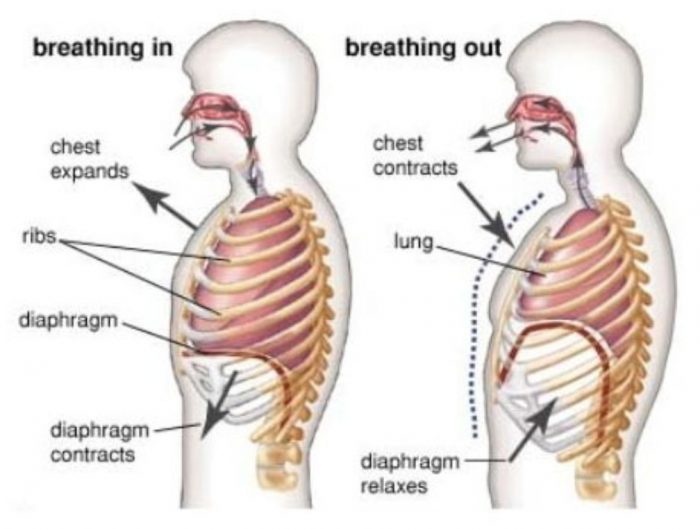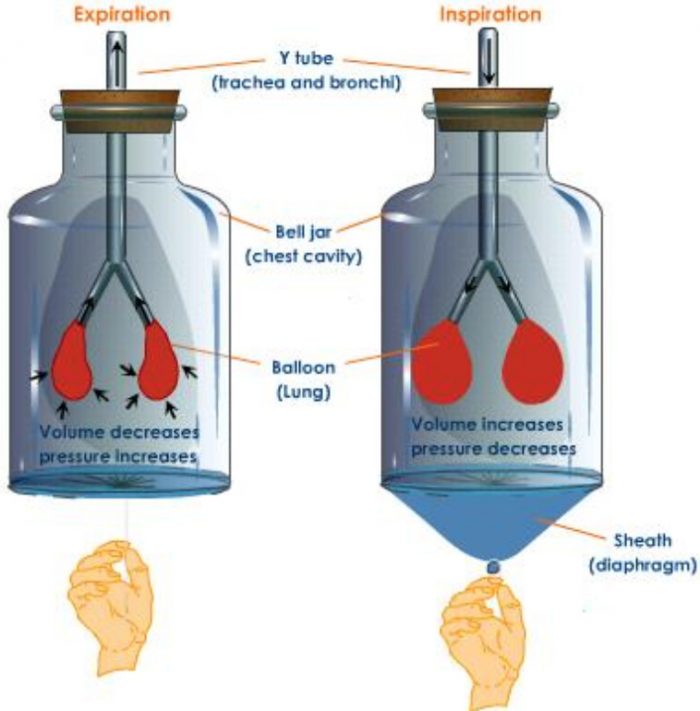Question 1 What is meant by breathing?
Question 2 Why does running make a person breathe faster?
Question 3 Why does an athlete breathe faster and deeper than usual even after finishing the race?
Question 4 Why do we feel hungry after a heavy physical exercise?
Question 5 What would happen if a potted plant is over watered for a long time? Explain?
Question 6 Explain why exhaled air contain less oxygen than inhaled air?
Question 7 Explain why exhaled air contain more carbon dioxide than inhaled air?
Question 8 Why exhaled air contains more water vapours than inhaled air?
Question 9 Explain why , when we exhale air from our mouth on to mirror, a patch of moisture is formed on the mirror surface?
Question 10 What is meant by inhalation and exhalation?
Question 11 Define the term breathing rate?
Question 12 Describe the mechanism of breathing in humans?
During breathing, we take air into our lungs through the nose, and then expel it. The air which we take into the lungs is rich in oxygen but the air expelled from the lungs is rich in carbon dioxide.
Contents
Breathing
Breathing is the process by which air rich in oxygen is taken inside the body of an organism and air rich in carbon dioxide is expelled from the body (with the help of breathing organs). Different organisms have different organs for breathing.
The breathing in human beings takes place through the organs called lungs.
The taking in of air rich in oxygen into the body during breathing is called ‘inhalation’ and giving out (or expelling) the air rich in carbon dioxide is called ‘exhalation’. Both, inhalation and exhalation take place regularly during breathing.
A breath means one inhalation plus one exhalation.
We ‘breathe in’ air to supply oxygen to the cells of our body (for the breakdown of food to release energy), and we breathe out’ to remove waste product carbon dioxide from our body (which is produced during the breakdown of food in the cells)
Breathing is a continuous process which goes on all the time and throughout our life and that of other animals as well as plants.
The mountaineers carry oxygen cylinders with them for breathing because the amount of air available to a person for breathing at high altitude is much less than that available on the ground.
Breathing Rate
The number of times person breathes in one minute is called breathing rate.
The average breathing rate in an adult human being at rest is 15-18 times per minute. Women breathe slightly faster than men.
The breathing rate of a person changes according to the oxygen requirements of the body.
1) The breathing rate of a person is the slowest when he is sleeping because minimum energy is required by the body during sleep which can be provided by a slow rate of breathing.
2) The breathing rate of a person increases with increased physical activity (like exercise, running, weightlifting, etc.). When the breathing rate increases, greater amount of air goes into the lungs. With more air going into the lungs, the blood can absorb oxygen at a faster rate. Thus, faster breathing supplies more oxygen to the body cells for producing more energy (by the rapid breakdown of food) needed for doing heavy physical exercise, etc.
When we run , we also take deep breaths so as to inhale more air (and get more oxygen) for the speedy release of energy from food. Athlete breathes faster and deeper than usual even after finishing a race. This is because during the race, the leg muscles of athlete have produced extra energy by doing anaerobic respiration (without using oxygen). By breathing faster and deeper, the athlete is giving back oxygen to the muscles which it could not give earlier at the time of running.
We feel hungry after doing a heavy physical exercise . This is because to provide extra energy for doing heavy physical exercise, the food has broken down very rapidly (by faster breathing) and made us feel hungry.
Children breathe about 20 to 30 times per minute
Mechanism of Breathing
The process of breathing takes place in our lungs.
(1) Lungs are connected to our nostrils (holes in the nose) through nasal passage (or nasal cavity) and windpipe.
(2) When we inhale air, it enters our nostrils , passes through nasal passage and windpipe, and reaches our lungs.
(3) Our two lungs hang in an airtight space in our body called chest cavity.
(4) Around the sides of the chest cavity is the rib cage with sheets of muscles between the ribs.
(5)The rib cage encloses the lungs in it.At the bottom of the chest cavity is a curved sheet of muscle called diaphragm .
(6) Breathing involves the movements of the rib cage and the diaphragm.
(a) Breathing in: When we breathe in (or inhale), then two things happen at the same time
(1) The muscles between the ribs contract causing the rib cage to move upward and outward, and
(2) the diaphragm contracts and moves downward.
The upward and outward movement of rib cage as well as the downward movement of diaphragm, both increase the space in the chest cavity and make it larger. As the chest cavity becomes larger, air is sucked in from outside into the lungs. The lungs get filled up with air and expand.
(b) Breathing out: When we breathe out (or exhale), then two things happen at the same time
(1) Muscles between the ribs relax causing the rib cage to move downward and inward and
(2) the diaphragm relaxes and moves upward.
The downward and inward movement of rib cage as well as the upward movement of diaphragm, both decrease the space in the chest cavity and make it smaller. As the chest cavity becomes smaller, air is pushed out from the lungs.
Different people can expand their chest by different amounts.
We can measure the maximum expansion in the chest size as follows: First measure the size of chest with a measuring tape while holding the breath, after exhaling normally. Then take a very deep breath (so as to cause maximum expansion in chest), hold the breath for a while and measure the size of the chest in this expanded position.The difference in the two readings of the measuring tape will give the maximum expansion in the size of the chest which can be brought about by us.
Activity : Mechanism of Breathing
A big bell jar is taken (The bell jar is a glass jar whose bottom is open). A glass tube branching into two smaller tubes at its lower end is fitted in the mouth of the bell jar with the help of a cork. Two balloons are tied at the two ends of the tube. A thin rubber sheet is tied around the open bottom of the bell jar. In this apparatus, the space inside the bell jar represents the chest cavity, the balloons represent the lungs whereas the rubber sheet represents the diaphragm.
(1) To show the process of breathing in air, we pull the rubber sheet downwards. In this case, the space in the bell jar increases, lowering the air pressure inside the bell jar. The air from outside rushes in through the tube into balloons due to which the balloons get inflated (their size increases).This shows the action of diaphragm during inhaling of air.
(2) To show the process of breathing out of air, we release the rubber sheet. In this case, the space in the bell jar decreases. The air from inside the balloons goes out through the tube due to which the balloons get deflated (their size decreases). This shows the action of diaphragm during exhaling of air.
When the diaphragm moves downward during inhaling, the lungs get filled with air. But when the diaphragm moves upward during exhaling, then the air is forced to go out of the lungs.
Air Which We Breathe During Respiration
The air which we breathe in from the atmosphere is called inhaled air and the air which we breathe out (from our lungs through nose or mouth) is called exhaled air.
The only difference in the inhaled air and exhaled air is that they contain different proportions of oxygen, carbon dioxide and water vapour.
(1) The Case of Oxygen: The air which we inhale contains a higher proportion of oxygen. Some of the oxygen of inhaled air is used up in breaking down glucose food during respiration. So, the exhaled air which comes out after the process of respiration contains a lower proportion of oxygen. Thus, exhaled air contains less oxygen than inhaled air.
(2) The Case of Carbon Dioxide: The air which we inhale contains a lower proportion of carbon dioxide. Now, during respiration when oxygen breaks down glucose food, then some carbon dioxide is produced. Thus, exhaled air contains more carbon dioxide than inhaled air.
(3) The Case of Water Vapour: The air which we inhale contains only a little of water vapour. When glucose (food) is broken down by oxygen during respiration, then water is also produced (along with carbon dioxide). So, the exhaled air contains a lot more water vapour than inhaled air.
If we exhale air on a mirror through our mouth, then a patch of moisture is formed on the mirror surface. This is because the exhaled air coming from our mouth contains a lot of water vapour. This water vapour condenses on the mirror surface to form tiny droplets of water which appear as a patch of moisture.
Activity : Carbon dioxide is produced during respiration
The apparatus consists of two boiling tubes and fitted with two-holed corks. The boiling tubes are connected through a special type of glass tube . The left arm of glass tube is short which goes in the boiling tube . The right arm of glass tube is long and dips in lime water in boiling tube.The boiling tube has another bent glass tube whose longer side dips in lime-water contained in it. The boiling tube has also another short, bent tube E in it which does not dip in lime-water.
We put the top end of the tube in mouth and breathe in and ‘breathe out gently.When we breathe in, then the inhaled air (fresh air) enters the glass tube and passes through the lime-water in boiling tube . And when we breathe out, then the exhaled air (coming from our lungs) passes through the lime-water in boiling tube . We continue to breathe in and breathe out for about five minutes.
We will find that the lime-water in boiling tube (in which inhaled air is passed) turns milky only slightly but the lime-water in boiling tube (in which exhaled air is passed) turns milky appreciably. This shows that less carbon dioxide is present in inhaled air but much more carbon dioxide is present in exhaled air.


nice
Wow wonderful really so helpful and useful for me thanks a lot to your website ☺☺☺☺☺
Thanks alot
Actually very helpful for me.